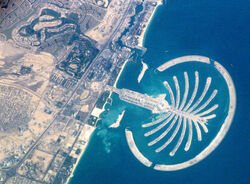Humanity has evolved to the point that it can now alter Earth's geography. Less ambitious than terraforming but of greater short-term significance is land reclamation - the process of gaining land area from what was once marsh or water.
In future land reclamation will become more common, as property costs continue to climb due to increased demand and constant supply. As Mark Twain said:
- "Buy land. They don't make it any more."
Mark Twain was wrong. Land reclamation does just that -- it creates land where there was not land before.
Four categories of land reclamation:
- Draining of marshes.
- Building of artificial islands.
- Floating pontoons built out over water.
- Housing built on stilts above water.
Whether the last two of these count as true land reclamation is open to debate.
Examples[]

Palm Island - An artificial Island
- Netherlands - much of the Netherlands is reclaimed marsh and is below sea level.
- Boston, Chicago.
- The fens in the UK, once marshland, now mostly rural agricultural land.
- More information - Wikipedia:Land reclamation
Technology[]
- Windmills - used in the Netherlands to continuously pump water from the polders.
- Dikes - large raised mounds that act as dams against the sea.
Reclaiming Deserts[]
See Terraforming for a discussion of how land reclamation of deserts is a stepping stone towards technology that can transform a planet.
- There could be unintended side effects of land reclamation on a large scale.
In many instances, Saharan dust travels all the way to the Caribbean. There, the dust plays a dual role. While it can carry bacteria and fungi that harm Caribbean corals, it also provides soil for the local islands. Without Saharan dust, few plants might grow in the Caribbean. Saharan dust may also play a role in mitigating the Atlantic hurricane season. On February 27, 2007, William Lau of NASA Goddard Space Flight Center and Kyu-Myong Kim of the University of Maryland published an article in EOS hypothesizing that repeated dust storms from Africa in summer 2006 blocked incoming sunlight, cooled the sea surface, and hampered hurricane development.
